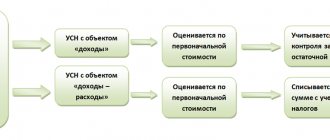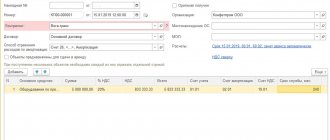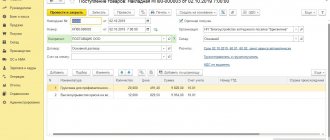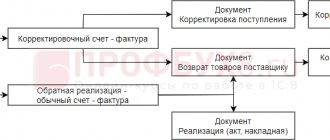How are fixed assets received?
It’s worth making a reservation right away. According to current regulations, accounting of fixed assets according to PBU 6/01 is carried out only by legal entities. The sources of formation of property assets of any organization are:
- Contribution to the authorized capital of the organization by founders and/or shareholders;
- Manufacturing (construction) by contract or household methods;
- Acquisition using own or borrowed funds;
- Others – barter or donation.
Despite some differences, all methods of receiving fixed assets lead to one thing - the acceptance of fixed assets for accounting - and are subject to a single algorithm, which we will consider, presenting it for convenience as a sequence of several steps. So,
How many years should OS documents be stored?
For storing primary documents confirming expenses in the form of depreciation charges, the Tax Code of the Russian Federation establishes a general period of four years. Taking into account the requirements of Article 252 of the Tax Code of the Russian Federation on the economic justification of expenses, this period is calculated from the moment the depreciation calculation is completed in tax accounting.
For accounting purposes, primary documents must be stored for at least five years after the reporting year (Article 29 of Law No. 402-FZ).
And the Order establishes that documents that confirm the correctness of the determination of depreciation must be stored permanently. The Order includes protocols, acts, calculations, depreciation statements, conclusions, etc.
Thus, let’s formulate a general rule for determining the storage period of a document: if different regulations establish different storage periods for the same document, you need to focus on a longer period (Ministry of Finance officials discussed this in letter dated January 19, 2021 No. 03- 03-06/1/2598).
When choosing a document storage period, be guided by a longer period. Thus, documents on determining the depreciation of fixed assets for tax purposes must be kept permanently.
The procedure for registering the disposal of fixed assets in a company
The most common situations of disposal of fixed assets from production activity are associated with one of the following circumstances:
- the company decided to sell the OS;
- The enterprise's fixed assets are recognized as subject to write-off.
Each of the above circumstances requires specific documentation.
If a company sells its OS, then, as in the case of a purchase, it is necessary to draw up an acceptance certificate for the OS (clause 81 of guidelines No. 91n). It is drawn up according to the rules and forms described above in relation to the situation with the receipt of OS by the company. That is, if a company sells an asset that is not a building, then the act can be drawn up in the OS-1 form. If the building is being sold, then the most suitable template for the act is OS-1a. And in the case when a company simultaneously sells a group of homogeneous fixed assets, the disposal should be formalized by act OS-1b.
NOTE! The above acts should be drawn up not only in a situation where the OS is directly sold, but also when an object is transferred by a company to the authorized capital of another organization, as well as when transferred free of charge to a third party.
Such documents must be completed in any case, regardless of who the buyer is (an individual or a company). This was indicated by the Department of Tax Administration of the Russian Federation for Moscow in a letter dated May 17, 2004 No. 26-12/33266.
The second possible option is that the company’s OS is outdated, has completely served the allotted time period, or has broken down as a result of the influence of some external factors, while restoring or repairing such an OS is not economically feasible for the company. Such an OS should be decommissioned.
But for this, paragraph 77 of methodological instructions No. 91n requires the creation of a special commission of production experts who will decide whether such an OS should be written off or not.
If such a commission decides not to restore an asset, but to write it off completely, then after receiving a written decision of the commission, the company will have to document the fact of disposal of the asset with a special act. Its form, as well as according to the previously described documents, can be developed by the company independently or selected from standardized ones. In the latter case, these will be the following forms:
- OS-4 - if the company writes off one asset that is not a motor vehicle (for motor transport, form OS-4a should be used);
- OS-4b - when not one fixed asset is written off, but a group of similar ones.
After the act of disposal of the fixed assets is drawn up, the accounting specialist puts a mark on the inventory card of the object that the fixed assets have been disposed of.
For information about what entries are made when disposing of fixed assets and how to calculate the retirement ratio, read the article . ”
Results
The primary forms of forms for accounting for fixed assets were developed and approved by Decree of the State Statistics Committee of January 21, 2003 No. 7. However, they are samples that are only recommended for use.
Therefore, the company, along with unified forms, can use document forms developed independently and including all mandatory details. You can find more complete information on the topic in ConsultantPlus. Free trial access to the system for 2 days.
What are the most common errors in documenting OS movement?
In practice, there are situations when a company forgets to formalize the acceptance of OS with the appropriate act, citing the fact that the legislator has not established a mandatory form for the application of such an act.
Read more: Where to get a driver’s license in Samara
This approach is incorrect, since since January 1, 2013, companies have been given the right to develop their own forms of accounting documents, including the form of the certificate of acceptance and transfer of fixed assets. There is no single mandatory form. But this does not mean that the act can not be drawn up. After all, if there is no act, this means that the company actually admits that the OS object is not yet ready for use.
IMPORTANT! Only after signing the acceptance and transfer certificate can the company open an inventory card for the OS object.
At the same time, in practice, some organizations violate the procedure for documenting fixed assets by first opening inventory cards (at the time the assets arrive at the company), and then only signing the act (when the OS is ready for use).
An inventory card is a document that acts as a biography for an OS object. The company maintains such a card throughout the entire service life of the OS. A new card can only be created when the object has undergone a radical modernization, as a result of which the company can no longer record all the characteristics of the OS in the old card.
Therefore, if a company reissues cards for some objects with some frequency, then these actions should also be considered erroneous.
Ways to get the maximum benefit from capitalizing an asset without documents
In business practice, situations sometimes arise when a company owns a fixed asset, but there are no primary documents on its acquisition. This can happen, for example, if, as a result of the inventory, an unaccounted fixed asset is revealed, or a third party plans to transfer the object free of charge, or the company has simply lost the primary documents on the OS and there is no way to restore them. In practice, several options for capitalizing such funds are used. They all have different tax consequences for the company.
Method one: identifying fixed assets based on inventory results
The easiest way is to identify such a fixed asset as a result of inventory. For property tax purposes, such an object is accepted for accounting at its current market value (clause 36 of the Guidelines for accounting of fixed assets, approved by order of the Ministry of Finance of Russia dated October 13, 2003 No. 91n). When determining such a cost, price lists of manufacturing organizations, information from state statistics bodies, trade inspectorates, or information in the media can be used. Professional appraisers may also be involved (paragraph 2, 3, paragraph 29 of the Methodological Instructions).
The market value of an object is recognized as income in tax accounting (clause 20, article 250, clauses 5, 6, article 274 of the Tax Code of the Russian Federation). In addition, property discovered during inventory is taken into account as a depreciable object (clause 1 of Article 257 of the Tax Code of the Russian Federation).
Note that in order to save on property tax, companies often underestimate the value at which the property is accepted for accounting. This is also beneficial for income tax purposes. After all, this amount will have to be recognized in tax income. This nuance is where the tax risk lies, so in order to avoid claims, the cost must be carefully supported by documents.
Thus, this method is disadvantageous for profitable companies. In addition to incurring property taxes, the company will have to recognize the market value of the property in income at a time. For an unprofitable company, this method of registering an operating system will not be so burdensome. Her payments will increase only by the amount of property tax.
Method two: receiving the property free of charge from the founder with a participation share of more than 50 percent
Fixed assets without documents can come from the founder - an individual whose share in the authorized capital is more than 50 percent. In this case, there will be no income tax losses, since, according to subparagraph 11 of paragraph 1 of Article 251 of the Tax Code of the Russian Federation, the cost of such an object is not taken into account when determining the tax base. But to maintain the benefit, the object cannot be transferred to third parties within one year from the date of its receipt.
For property tax purposes, a fixed asset received from the founder free of charge is valued in the same way as in the case of its identification during inventory - at market value (clauses 7, 10, 12 of PBU 6/01).
However, for tax accounting purposes, a slightly different methodology is used. Property received free of charge is included in the fixed assets at a cost determined taking into account the provisions of Article 40 of the Tax Code of the Russian Federation, but not lower than the residual value (clause 1 of Article 257, clause 8 of Article 250 of the Tax Code of the Russian Federation). Information about the price must be confirmed by the taxpayer - the recipient of the property, documented or through an independent assessment.
Thus, if the founder provides documents confirming the purchase of a fixed asset at a price higher than the market price, then exactly this amount will be depreciated, which can bring tax benefits to the company. At the same time, an individual will not have any increase in personal income tax.
In general, the gratuitous transfer of property is subject to VAT (subclause 1, clause 1, article 146 of the Tax Code of the Russian Federation). However, in our case, the transferring party is an individual – a VAT non-payer. Therefore, there will be no losses on this tax (as well as deductions).
The main difference between this method and the previous one is that there is no need to recognize income in tax accounting, while tax expenses arise and are assessed on the basis of the founder’s primary documents. In this case, a difference may arise in the initial cost of the object in accounting and tax accounting, which is beneficial for reducing property taxes.
Method three: purchasing an object from a friendly individual
In practice, companies often arrange for the purchase of an object at the required cost from a third-party individual who is not formally associated with the organization.
Here it should be taken into account that an individual may have to pay personal income tax at a rate of 13 percent on the amount of income, that is, revenue minus a property deduction in the amount of 125 thousand rubles or confirmed acquisition costs (subclause 1, clause 1, article 220 of the Tax Code of the Russian Federation ). This can be avoided if the individual has documents confirming ownership of the object for more than three years. The individual himself is obliged to calculate personal income tax (subclause 2, clause 1, article 228 of the Tax Code of the Russian Federation) by submitting the appropriate declaration.
If the seller is an entrepreneur using a “simplified” system with an “income” base, this will reduce the total burden of all participants as a whole. After all, the seller’s tax will be calculated at a rate of 6, not 20 percent. Tax risks will arise only if tax authorities have the opportunity to apply price controls on this transaction (Article 40 of the Tax Code of the Russian Federation). The danger will increase if, as a result of a counter check, it turns out that the “simplifier” took this basic tool “out of thin air.”
For property tax purposes, a company's original cost will be the same as the purchase price, just as in tax accounting. Therefore, a contradiction arises here in the company’s desire: by increasing the acquisition price, it will reduce profit tax, and by decreasing it, it will reduce property tax. Consequently, the second option will be more profitable for profitable companies, and the first one for unprofitable companies.
Method four: purchasing a fixed asset from a fly-by-night company
In order to be able to recover VAT from the budget, companies often fabricate primary documents for the discovered fixed asset, indicating that it was purchased from a third party. This is illegal, but in practice it is very popular.
In this case, the organization formally achieves its goal - it has the right to apply a VAT deduction and forms the amount of tax expenses. However, this deduction may be considered unfounded by tax authorities if, during a counter-check, it turns out that the counterparty who allegedly sold the fixed asset does not pay taxes and generally exists only on paper. In this case, the amount of expenses for the acquisition of the object, that is, depreciation, will be excluded from tax expenses.
As a result, such a method of capitalizing fixed assets, under certain conditions, can bring the management of an organization to criminal liability (Article 199 of the Criminal Code).
The benefit of the method depends on whether the company is profitable or unprofitable
To facilitate the analysis, we have summarized the described methods in Table 1 on page 45. It can be seen that if the company is profitable, then the receipt of fixed assets is most advantageous through the gratuitous receipt of property from the founder with a share of more than 50 percent in the authorized capital. In this case, no income arises, and expenses are recognized in the general manner, through depreciation. The risk of filing tax claims is minimal.
If the company is unprofitable, then its tax liability will be affected only by property tax. Therefore, it is more profitable for such a company to choose the option of capitalizing the object, which allows minimizing the initial cost in accounting. For example, register an asset based on inventory results. This will allow, firstly, to reduce the amount of loss in a lump sum in the current tax period and, as a result, avoid being called to the loss commission, and secondly, to pay property tax to a minimum.
in numbers Let's say the market value of the property identified during the inventory is 1 million rubles. In case of gratuitous transfer from the founder or purchase, the cost is 2 million rubles. The useful life of the object is 5 years. Property tax in the region where the company operates is 2.2 percent.
The calculation of the tax burden presented in Table 2 is carried out in general for all participants, since it is assumed that they are friendly persons.
Benefits and risks of methods for capitalizing fixed assets without documents. Table 1
| Method of posting | Company | Property tax losses for the entire period, rub. | Losses on income tax, single tax, personal income tax (for all participants), rub. | Savings on income tax as a result of recognizing expenses, rub. | VAT savings, rub. | Change in tax burden, rub. |
| Identification during inventory | Profitable | 55 000 | 200,000 (RUB 1,000,000 × 20%) | 211,000 ((RUB 1,000,000 + + RUB 55,000) × 20%) | 0 | Increase by 44,000 (200,000 + + 55,000 – 211,000) |
| Unprofitable | 55 000 | 0 | 0 | 0 | Increase by 55,000 | |
| Free receipt from the individual founder | Profitable | 55 000 | 0 | 411,000 ((2,000,000 rub. + + 55,000 rub.) × 20%) | 0 | Decrease by 356,000 (55,000 – – 411,000) |
| Unprofitable | 55 000 | 0 | 0 | 0 | Increase by 55,000 | |
| Purchase from an individual | Profitable | 110 000 | 243,750 ((RUB 2,000,000 – – RUB 125,000) × 13%) | 422,000 ((2,000,000 rub. + + 110,000 rub.) × 20%) | 0 | Decrease by 68,250 (110,000 + + 243,750 – 422,000) |
| Unprofitable | 110 000 | 0 | 0 | Increase by 353,750 (110,000 + 243,750) | ||
| Purchasing from a “simplified” person with the object “income” | Profitable | 110 000 | 120,000 (RUB 2,000,000 × 6%) | 422,000 ((2,000,000 rub. + + 110,000 rub.) × 20%) | 0 | Decrease by 192,000 (110,000 + + 120,000 – 422,000) |
| Unprofitable | 110 000 | 0 | 0 | Increase by 230,000 (110,000 + 120,000) | ||
| Buying from a fly-by-night company in general mode | Profitable | 110 000 | 0 (“fly-by-night” does not pay taxes) | 422,000 ((2,000,000 rub. + + 110,000 rub.) × 20%) | 360,000 (RUB 2,000,000 × 18%) | Decrease by 672,000 (110,000 – 422,000 – 360,000) |
| Unprofitable | 110 000 | 0 | Decrease by 250,000 (110,000 – 360,000) |








